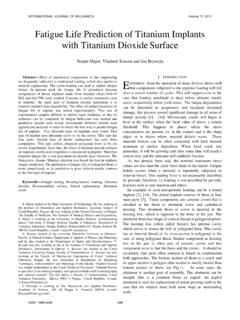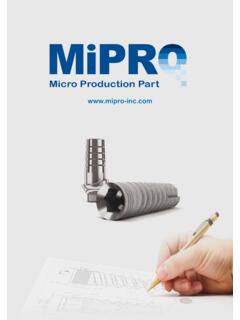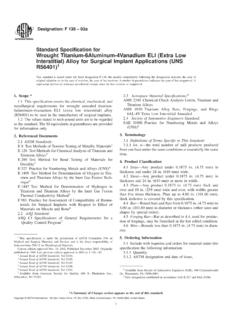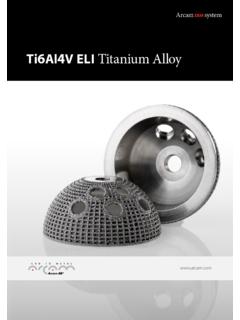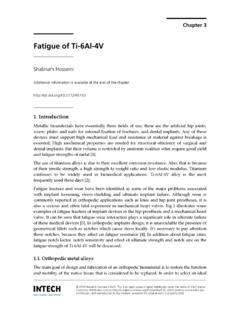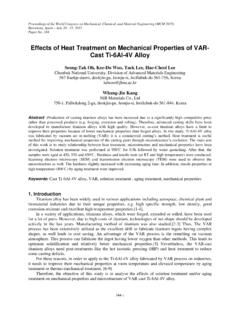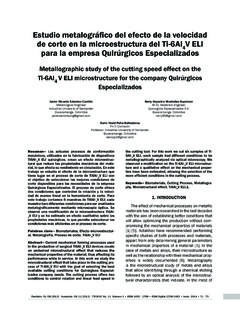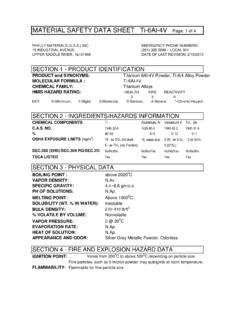Transcription of DENTSPLY International - Proteket
1 DENTSPLY International DENTSPLY Implants Safety Data Sheet Date Issued: 7 January 2014 Document Number: N/A Date Revised: N/A Revision Number: 1 1. PRODUCT IDENTIFICATION Trade Name (as labeled): titanium Alloy 6Al-4V (grade 5) Chemical Name: titanium ASTM F136 6Al4V ELI Product Identifier (Part/Item Number): N/A Number: N/A Dangerous Goods Classification: N/A Recommended Use: Used for production of ATLANTIS abutments ( titanium ) Restrictions on Use: N/A Manufacturer/Supplier Name: DENTSPLY Implants Manufacturer/Supplier Address: Aminogatan 1, Box 14 SE-431 21 M lndal, Sweden Manufacturer/Supplier Telephone Number: +46 31 376 35 00 (Product Information) Emergency Contact Telephone Number: +46 31 376 35 00 Email address: Please see 2. HAZARD(s) IDENTIFICATION Hazard/Danger Classification: Health Environmental Physical None N/A None 3. COMPOSITION AND INFORMATION ON INGREDIENTS Hazardous Components WT % Nitrogen, max Carbon, max Hydrogen, max Iron, max Oxygen, max Aluminium Vanadium titanium Balance 4.
2 FIRST-AID MEASURES Routes of Exposure First Aid Instructions Eye In case of contact, immediately flush eyes with plenty of water for at least 15 minutes. Seek medical attention, if necessary. Skin If irritation develops, remove contaminated clothing immediately and wash contaminated skin with soap or mild detergent water. If irritation persists, seek medical attention. Inhalation In case overexposure, immediately move person from contaminated area to fresh air at once. Give artificial respiration if breathing has stopped, or oxygen, if necessary. Get medical attention, if necessary. Ingestion Seek medical attention immediately. Most important symptoms of exposure N/A Other N/A Note to Physicians (Treatment, Testing, and Monitoring) N/A 5. FIRE-FIGHTING MEASURES Suitable Extinguishing Media: Dry salt or Type D fire extinguisher Fire Fighting Procedures: Remove uninvolved material; allow fire to burn out. Fire can be controlled by converting dry salt or powder from Type D fire extinguisher.
3 Carbon dioxide is not effective. Specific Hazards Arising from the Chemical: Dry titanium burns slowly while releasing much heat. Water applied to burning titanium may cause an explosion. Piled chips may burn vigorously. Precautions for Fire Fighters: N/A 6. ACCIDENTAL RELEASE MEASURES Personal Precautions, PPE and Emergency Procedures: Utilize recommended protective clothing and equipment. Environmental Precautions: N/A Methods and Materials for Containment and Clean-up: Clean spills in a manner that does not disperse dust into the air. Spill area can be washed with water. Collect wash water for approved disposal. Keep from entering water or ground water. 7. HANDLING AND STORAGE Precautions for Safe Handing: N/A Conditions for Safe Storage: Store in a dry place away from direct sunlight, heat and incompatible materials. Reseal containers immediately after use. Store away from food and beverages. 8. EXPOSURE CONTROLS/PERSONAL PROTECTION Occupational Exposure Limits: N/A Biological Exposure Limits: N/A Appropriate Engineering Controls: N/A Individual Protection Measures (PPE) Specific Eye/face Protection: Use face shield (8 minimum) or goggles if burning and grinding.
4 If welding, use a hood providing full face coverage for protection from ultraviolet radiation. Specific Skin Protection: Use appropriate protective clothing for protection of exposed skin areas from heat, sparks and ultraviolet radiation during forging, grinding and welding. Specific Respiratory Protection: A properly fitted NIOSH-approved, dust fume respirator should be wornd during welding or burning, when air contaminant levels exceed OSHA permissible exposure levels (PELs) or ACGIH threshold limit values (TLVs). Respiratory Protection Standard (29 CFR ) and other applicable regulations. Specific Thermal Hazards: N/A Environmental Exposure Controls: N/A General Hygiene Considerations and Work Practices: N/A Protective Measures During Repair and Maintenance of Contaminated Equipment: N/A 9. PHYSICAL AND CHEMICAL PROPERTIES Appearance: Gray metallic solid Explosive limits: N/A Odor: Odorless Vapor pressure: N/A Odor threshold: N/A Vapor density: N/A pH: N/A Relative density: N/A Melting/freezing point (F): 3050 Solubility: Insoluble Initial boiling point and range (F): 5930 Partition coefficient: n-octanol/water: N/A Flash point: N/A Auto-ignition temperature (F): 2200 for metal in air, 480 for powder in air Evaporation rate: N/A Decomposition temperature: N/A Flammability: N/A Viscosity: N/A Explosive Properties: N/A Oxidizing Properties: N/A 10.
5 STABILITY AND REACTIVITY Reactivity:: Stable Chemical Stability: N/A Possibility of Hazardous Reactions: N/A Conditions to Avoid: Open flam and heat Incompatible materials: Strong oxidizing and reducing agents Hazardous Decomposition Products: N/A 11. TOXICOLOGICAL INFORMATION Potential Health Effects: No toxic effects would be expected from its inert solid form or under normal usage such as forging and heating. Prolonged, repeated exposure to fumes or dusts generated during cutting, grinding or welding may cause adverse health effects associated with the following constituents: Inhalation of metal fumes or dust: Aluminum not generally regarded as serious industrial health hazard. Chromium the dusts of chromium metal are usually reported to be relatively nontoxic, although there are reports of skin ulcers, usually on hands, or a perforated nasal septum. Some insoluble chromium compounds are suspect carcinogens. Columbium (Niobium) - no reports of human intoxication.
6 Iron siderosis, no fibrosis. Molybdenum irritation to the nose and throat, weight loss, and digestive disturbances in animals. No industrial poisoning has been reported. Tantalum no systemic effects from industrial exposure have been reported in humans. Tin dust of tin oxides has caused pneumoconiosis, which is relatively benign. titanium generally considered to be in the nuisance dust category. Vanadium irritant to the conjunctivae and respiratory tract. May lead to pulmonary involvement. Signs and symptoms of poisoning are pallor, greenish-black discoloration of the tongue, cough, conjunctivitis, pain in the chest, bronchitis, rales and rhonchi, bronchospasm, tremor of the fingers and arms, and radiographic reticulation. Zirconium studies of several zirconium compounds conclude that zirconia is an element of low toxicity. NOTE: Some fume constituents pose more potential hazards than other, depending upon their inherent toxicity and concentration.
7 Of special concern are chromium, vanadium, nickel and possibly titanium . It is advised that your particular operation be evaluated by competent health professionals of determine whether or not a hazard exists. Eyes: May cause irritation. Skin: Dermatitis due to sensitization may occur in some individuals from exposure to chromium and nickel fumes. Columbium (niobium) has been reported to be a skin irritant. Ingestion: Ingestion of dust may cause nausea and/or vomiting. Exposure limits: OSHA nuisance dust standard apply to components shown as None . Chronic Health Effects: N/A Carcinogenicity: N/A Mutagenicity: N/A Medical Conditions Aggravated by Exposure: N/A Acute Toxicity Data: N/A Reproductive Toxicity Data: N/A Specific Target Organ Toxicity (STOT): Single Exposure: N/A Repeated Exposure: N/A 12. ECOLOGICAL INFORMATION Toxicity: N/A Persistence and Degradability: N/A Bio-accumulative Potential: N/A Mobility in Soil: N/A Other Adverse Effects: N/A Results of PBT/vPvB Assessment: N/A 13.
8 DISPOSAL CONSIDERATIONS Regulations: N/A Properties (Physical/Chemical) Affecting Disposal: N/A Waste Treatment Recommendations: N/A 14. TRANSPORT INFORMATION UN Identification Number: N/A UN Proper Shipping Name: N/A Transport hazard class(es): N/A Packing Group: N/A Special precautions for user: N/A 15. REGULATORY INFORMATION Federal Regulations Comprehensive Environmental Response and Liability Act of 1980 (CERCLA): N/A Toxic Substances Control Act (TSCA): N/A Clean Water Act (CWA): N/A Clean Air Act (CAA): N/A Superfund Amendments and Reauthorization Act (SARA) Title III Information: N/A SARA Section 311/312 (40 CFR 370) Hazard Categories: N/A Immediate Hazard: N/A Pressure Hazard: N/A Delayed Hazard: N/A Reactivity Hazard: N/A Fire Hazard: N/A This product contains the following toxic chemical(s) subject to reporting requirements of SARA Section 313 (40 CFR 372): Components # WT % N/A N/A N/A State Regulations California Proposition 65: This product contains the following chemicals(s) known to the State of California to cause cancer, birth defects or reproductive harm (if blank, the product does not contain Proposition 65 regulated chemicals): Components # WT % N/A N/A N/A International Regulations Canadian Environmental Protection Act.
9 N/A Canadian Workplace Hazardous Materials Information System (WHMIS): N/A European Inventory of Existing Chemicals (EINECS): N/A European Chemical Agency (ECHA) REACH (Registration, Evaluation, Authorization and Restriction of Chemicals): N/A 16. OTHER INFORMATION Date of SDS Preparation/Revision: 7 January 2014 Data Sources: Global Product Management Digital Implant Solutions
